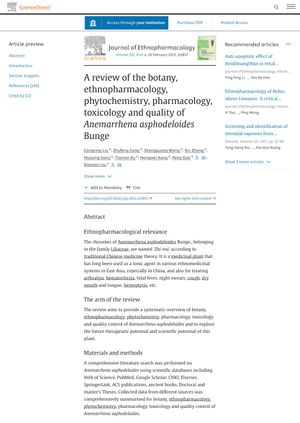A Review of the Botany, Ethnopharmacology, Phytochemistry, Pharmacology, Toxicology, and Quality of Anemarrhena Asphodeloides Bunge
October 2022
in “
Journal of Ethnopharmacology
”

TLDR The plant Anemarrhena asphodeloides has multiple health benefits but its safety at certain doses is uncertain.
The document reviews the botany, traditional uses, phytochemistry, pharmacological effects, toxicity, and quality of Anemarrhena asphodeloides, a plant used in traditional Chinese medicine. The plant, also known as 'Zhi-mu', is used to treat various conditions including allergic diseases, diabetes, fever, thirst, and respiratory tract inflammation. It contains 269 compounds, with steroidal saponins and flavonoids being the main bioactive substances. Modern research has confirmed its various pharmacological effects, including promoting hair growth, anti-inflammatory, antidiabetic, antiosteoporotic, antiallergic, and anti-ageing effects. However, the potential toxicity of A. asphodeloides is still debated, with some studies showing significant cytotoxicity at certain concentrations. The quality of A. asphodeloides is currently assessed by determining the content of mangiferin and timosaponin BⅡ.



